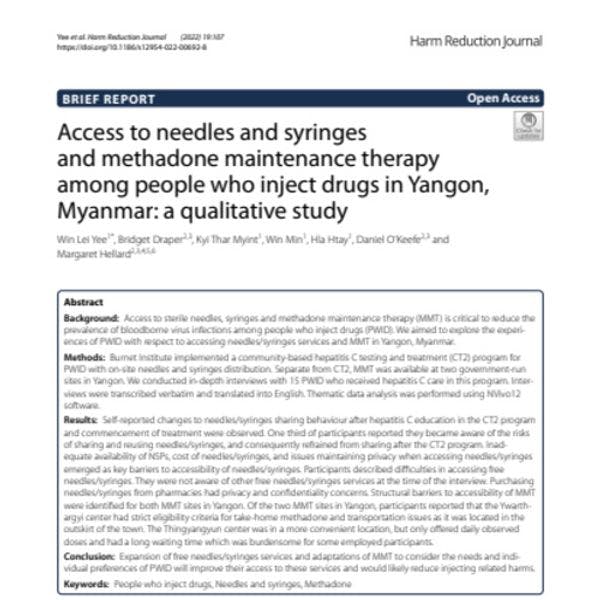Access to needles and syringes and methadone maintenance therapy among people who inject drugs in Yangon, Myanmar
By Win Lei Yee, Bridget Draper, Kyi Thar Myint, Win Min, Hla Htay, Daniel O’Keefe & Margaret Hellard
Background
Access to sterile needles, syringes and methadone maintenance therapy (MMT) is critical to reduce the prevalence of bloodborne virus infections among people who inject drugs (PWID). We aimed to explore the experiences of PWID with respect to accessing needles/syringes services and MMT in Yangon, Myanmar.
Methods
Burnet Institute implemented a community-based hepatitis C testing and treatment (CT2) program for PWID with on-site needles and syringes distribution. Separate from CT2, MMT was available at two government-run sites in Yangon. We conducted in-depth interviews with 15 PWID who received hepatitis C care in this program. Interviews were transcribed verbatim and translated into English. Thematic data analysis was performed using NVivo12 software.
Results
Self-reported changes to needles/syringes sharing behaviour after hepatitis C education in the CT2 program and commencement of treatment were observed. One third of participants reported they became aware of the risks of sharing and reusing needles/syringes, and consequently refrained from sharing after the CT2 program. Inadequate availability of NSPs, cost of needles/syringes, and issues maintaining privacy when accessing needles/syringes emerged as key barriers to accessibility of needles/syringes. Participants described difficulties in accessing free needles/syringes. They were not aware of other free needles/syringes services at the time of the interview. Purchasing needles/syringes from pharmacies had privacy and confidentiality concerns. Structural barriers to accessibility of MMT were identified for both MMT sites in Yangon. Of the two MMT sites in Yangon, participants reported that the Ywarthargyi center had strict eligibility criteria for take-home methadone and transportation issues as it was located in the outskirt of the town. The Thingyangyun center was in a more convenient location, but only offered daily observed doses and had a long waiting time which was burdensome for some employed participants.
Conclusion
Expansion of free needles/syringes services and adaptations of MMT to consider the needs and individual preferences of PWID will improve their access to these services and would likely reduce injecting related harms.
